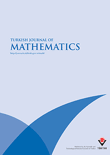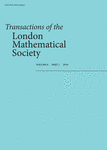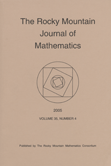
JP Journal of Algebra Number Theory and Applications
Scope & Guideline
Exploring the Depths of Algebra and Number Theory
Introduction
Aims and Scopes
- Algebraic Structures and Theory:
The journal emphasizes research on various algebraic structures such as rings, groups, algebras, and modules. It explores their properties, classifications, and applications, contributing significantly to the theoretical advancements in algebra. - Number Theory and Diophantine Equations:
A core area of focus is number theory, particularly the study of Diophantine equations and their solutions. This includes investigations into prime numbers, congruences, and other number-theoretic functions. - Cryptography and Security Applications:
The journal highlights the application of algebraic concepts in cryptography, particularly in the design and analysis of cryptographic schemes and protocols, showcasing the relevance of algebraic methods in modern security contexts. - Graph Theory and Algebraic Applications:
There is a notable interest in the intersection of graph theory and algebra, examining how algebraic methods can be applied to solve problems in graph theory, enhancing both fields. - Computational Mathematics:
Research involving computational techniques and algorithms in algebra and number theory is also a vital part of the journal's scope, addressing practical applications and efficiency in computations. - Emerging Mathematical Theories:
The journal encourages exploration of new theories and methodologies that emerge within algebra and number theory, fostering innovation and theoretical development.
Trending and Emerging
- Advanced Cryptographic Techniques:
There is a significant increase in research related to cryptography, particularly the development of new schemes and security models, indicating a strong trend towards applying algebraic methods in securing digital information. - Algebraic Geometry and Curves:
Emerging themes in algebraic geometry, particularly concerning algebraic curves and their properties, suggest a growing interest in the interplay between algebra and geometric structures. - Computational Algebra and Algorithms:
A marked trend in computational approaches within algebra, including algorithmic solutions to complex algebraic problems, reflects the increasing importance of computational tools in modern mathematical research. - Interdisciplinary Applications of Algebra:
Research that bridges algebra with other disciplines, such as physics, computer science, and engineering, is on the rise, showcasing the versatility and applicability of algebraic concepts in various fields. - Higher-Dimensional Algebraic Structures:
There is a growing interest in studying higher-dimensional algebraic structures and their implications, indicating a trend towards more abstract and generalized algebraic theories.
Declining or Waning
- Classical Algebraic Structures:
There has been a noticeable decrease in papers dedicated to traditional topics in classical algebra, such as basic group theory and ring theory, which may suggest a shift towards more contemporary and applied algebraic studies. - Elementary Number Theory:
Papers focusing on elementary number theory concepts, such as simple properties of integers and basic prime number theory, have become less frequent, possibly indicating a move towards more complex and abstract aspects of number theory. - Conventional Diophantine Analysis:
The analysis of classical Diophantine equations has seen a decline, with fewer papers addressing standard methods and solutions, which may reflect a broader interest in more modern or computational approaches to number theory. - Static Applications of Algebra:
Research that applies algebraic concepts in static or traditional contexts has diminished, suggesting a growing preference for dynamic applications, particularly in technology and cryptography. - Historical Perspectives in Algebra:
Themes that explore historical or foundational aspects of algebra appear to be waning, as the focus shifts more towards innovative applications and current research challenges.
Similar Journals

Turkish Journal of Mathematics
Fostering Excellence in Diverse Mathematical DisciplinesTurkish Journal of Mathematics is a prestigious academic publication dedicated to the advancement of mathematical research across a variety of subfields. Established in 1995 and published by the Tubitak Scientific & Technological Research Council Turkey, this journal has built a solid reputation, especially noted for its significant contributions to the field over the years, with its convergence spanning from 1995 to 2002 and again from 2006 to 2024. The journal, which holds a commendable Q2 ranking in Mathematics (miscellaneous) and is positioned in the 66th percentile of Scopus rankings for General Mathematics, aims to disseminate high-quality original research, reviews, and innovative methodologies to advance both theoretical and applied mathematics. Researchers, professionals, and students alike will find invaluable resources within its pages, providing insights that are pivotal for academic and practical applications in mathematics. Although it does not currently offer open access options, the journal remains an essential platform for those looking to engage with the forefront of mathematical inquiry.

Transactions of the London Mathematical Society
Unlocking Innovations in Mathematics, Open to AllTransactions of the London Mathematical Society is a prestigious journal published by WILEY, dedicated to advancing the field of mathematics across various sub-disciplines. With its commitment to Open Access since 2014, the journal ensures that research findings are widely disseminated and accessible to a global audience, enhancing collaboration and innovation in the mathematical community. Based in the United States, this journal enjoys a prominent position within the academic landscape, evidenced by its Q1 ranking in the 2023 Mathematics (miscellaneous) category and its ranking of 181 out of 399 in the General Mathematics category on Scopus, placing it at the 54th percentile. The journal publishes high-quality, peer-reviewed research articles and surveys that aim to foster advanced study and discussion in mathematical sciences, making it an invaluable resource for researchers, professionals, and students alike. With a focus on original research and significant contributions, the Transactions of the London Mathematical Society continues to play a crucial role in the evolution of mathematical inquiry.

ROCKY MOUNTAIN JOURNAL OF MATHEMATICS
Pioneering Research for a Dynamic Mathematical CommunityROCKY MOUNTAIN JOURNAL OF MATHEMATICS, published by the Rocky Mountain Math Consortium, serves as a critical platform for researchers and practitioners in the field of mathematics since its inception in 1971. With a notable presence in the academic community, this journal covers a broad spectrum of mathematical disciplines, positioning itself in the Q2 category for Mathematics (miscellaneous) as of 2023. Despite being a subscription-based journal, it is recognized for its rigorous peer-review process and contributions to theoretical and applied mathematics, helping to advance knowledge and foster collaboration among mathematicians. The journal's ISSN number is 0035-7596 and its E-ISSN is 1945-3795, reflecting its commitment to accessibility and dissemination of high-quality research. Based in Tempe, Arizona, at Arizona State University, the journal continues to play an important role in shaping contemporary mathematical discourse through well-researched articles and innovative studies, aiming to bridge gaps between various mathematical subfields and engage a diverse audience, including students and established researchers alike.

RAMANUJAN JOURNAL
Elevating the discourse in Algebra and Number Theory.The Ramanujan Journal, published by Springer, is a premier academic journal dedicated to advancing research in the fields of Algebra and Number Theory. With an ISSN of 1382-4090 and an E-ISSN of 1572-9303, this journal has established itself as a vital platform for disseminating high-quality research from 1997 through 2024. The 2023 category quartiles rank it in Q1 for Algebra and Number Theory, reflecting its rigorous selection standards and significant impact in the mathematics community, evidenced by its Scopus rank of 53 out of 119 in its category. Although it does not currently offer open access, the journal is pivotal for researchers and professionals seeking to engage with cutting-edge advancements and comprehensive studies in these mathematical disciplines. The Ramanujan Journal represents a critical resource for students and scholars alike, fostering a deeper understanding and innovative exploration of algebraic and number-theoretical concepts.

European Journal of Mathematics
Bridging Theory and Practice in MathematicsWelcome to the European Journal of Mathematics, a prominent publication that serves as a vital platform for disseminating high-quality research in the field of mathematics. Published by Springer International Publishing AG, this journal has witnessed significant growth since its inception in 2015 and is recognized for its contributions within the Q2 category of Mathematics (miscellaneous) as per the 2023 rankings. With an ISSN of 2199-675X and an E-ISSN of 2199-6768, the journal aims to foster innovation and collaboration among researchers, professionals, and students alike. Although it operates under a traditional access model, the journal's commitment to advancing mathematical knowledge and applications cannot be overstated. Positioned among the top-tier publications, the European Journal of Mathematics is an essential resource that encourages the exploration of emerging trends and theories in mathematics, making it indispensable for anyone striving to stay at the forefront of this dynamic field.

Periodica Mathematica Hungarica
Unveiling the Depths of Mathematical Knowledge.Periodica Mathematica Hungarica is a prestigious academic journal published by Springer, focusing on the field of mathematics, with a particular emphasis on miscellaneous mathematical studies. Established in 1971, this journal has maintained its commitment to advancing mathematical research and its applications, making significant contributions over its converged years through 2024. With a Q2 ranking in the mathematics category as of 2023, it establishes itself as a vital resource within the mathematical community. Researchers and academics will find its inclusion in the Scopus database, ranking #189 out of 399 in general mathematics, indicative of its impact and relevance. Although it does not feature open access, the journal provides a wealth of high-quality peer-reviewed articles, thereby serving as an essential platform for the dissemination of innovative mathematical theories, methodologies, and findings. Engaging with the content of Periodica Mathematica Hungarica is crucial for anyone looking to stay at the forefront of mathematical research and development.

Tsukuba Journal of Mathematics
Elevating the Discourse in Mathematics for Global ImpactTsukuba Journal of Mathematics is a distinguished publication dedicated to advancing the field of mathematics through the dissemination of innovative research and comprehensive studies. Published by the University of Tsukuba, Department of Mathematics, this journal serves as a vital platform for mathematicians, researchers, and students to engage with cutting-edge mathematical theories and methodologies. Although currently not available as an open-access journal, it maintains a strong academic presence, contributing significantly to the global mathematical landscape. The journal invites submissions across various branches of mathematics, aiming to foster scholarly communication and collaboration. The ISSN 0387-4982 and the E-ISSN 2423-821X further establish its credibility and accessibility among the academic community, supporting its critical objective of facilitating high-quality research output. Situated in Tsukuba, Japan, a hub for scientific research and development, the Tsukuba Journal of Mathematics is committed to bridging gaps in mathematical knowledge and encouraging exploration of novel ideas.

Mediterranean Journal of Mathematics
Empowering the Next Generation of MathematiciansThe Mediterranean Journal of Mathematics, published by SPRINGER BASEL AG, is a prominent platform dedicated to the advancement of mathematical research and education. Since its inception in 2004, this journal has been pivotal in disseminating high-quality research across various fields of mathematics, currently holding a notable Q2 ranking in the miscellaneous mathematics category as of 2023. With its ISSN 1660-5446 and E-ISSN 1660-5454, the journal enjoys a respected position in the academic community, evident by its Scopus rank of 129 out of 399 in General Mathematics, placing it in the 67th percentile. While primarily a subscription-based journal, it remains committed to providing a comprehensive resource for researchers, professionals, and students, fostering dialogue and exploration within the mathematical sciences. The Mediterranean Journal of Mathematics, based in Basel, Switzerland, continues to contribute significantly to the evolution of mathematical theory and practice, marking its relevance as we approach its 20th anniversary in 2024.

Analele Stiintifice ale Universitatii Ovidius Constanta-Seria Matematica
Connecting Ideas and Insights in the World of MathematicsAnalele Stiintifice ale Universitatii Ovidius Constanta-Seria Matematica is a prominent open-access journal established by OVIDIUS UNIV PRESS in Romania, dedicated to advancing the fields of mathematics, specifically in Analysis and Applied Mathematics. Since its inception, the journal has emphasized the dissemination of high-quality research, making it accessible to a global audience. With an ISSN of 1224-1784 and E-ISSN 1844-0835, it has positioned itself within the academic community, achieving a respectable Q3 ranking in both analysis and applied mathematics in 2023, reflecting its commitment to rigorous scholarship. The journal spans a considerable publication window from 2009 to 2024, catering to the ongoing developments in mathematical sciences and their applications. Researchers, professionals, and students alike will find valuable insights and contributions that enrich their understanding and foster collaboration within the mathematical community. The journal's headquarters is based at the Faculty of Mathematics & Computer Science, Bulevardul Mamaia 124, Constanta, Romania.

ALGEBRA UNIVERSALIS
Advancing Mathematical FrontiersALGEBRA UNIVERSALIS is a prestigious academic journal published by Springer Basel AG, dedicated to the exploration and advancement of mathematical research, particularly within the realms of algebra, number theory, and logic. Established in 1971, this journal continues to provide a platform for innovative research and discourse, contributing significantly to its fields of study over more than five decades. With its current classification in the Q2 quartile for both Algebra and Number Theory and Logic, ALGEBRA UNIVERSALIS ranks prominently within the mathematical community. Although it is not an open-access journal, it offers numerous subscription options for individuals and institutions seeking to stay current with the latest developments and findings. The journal’s commitment to quality research makes it an essential resource for researchers, professionals, and students aiming to deepen their understanding and knowledge of advanced mathematical theories and methodologies.